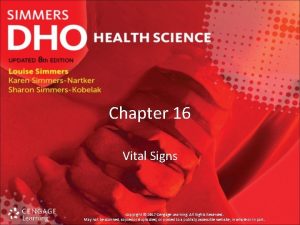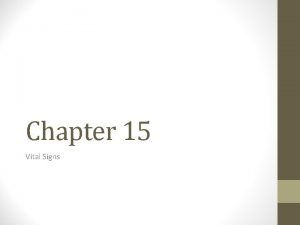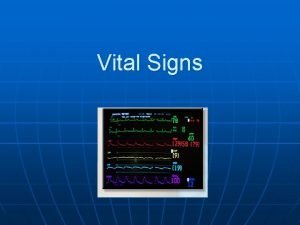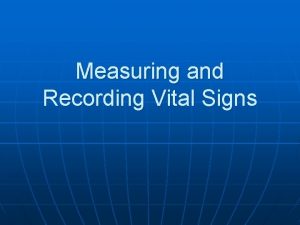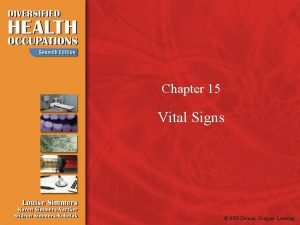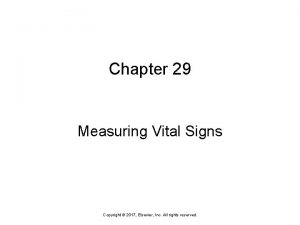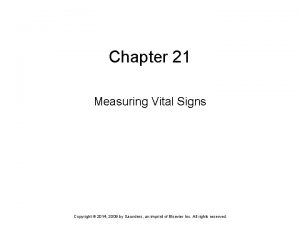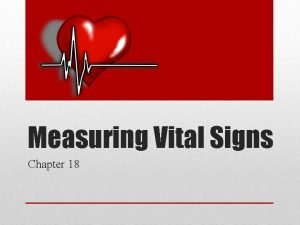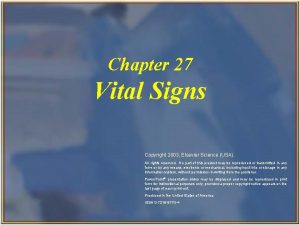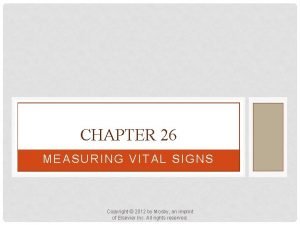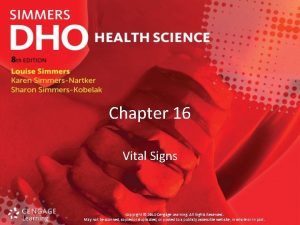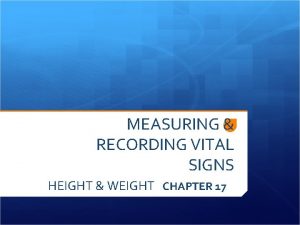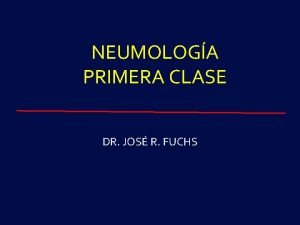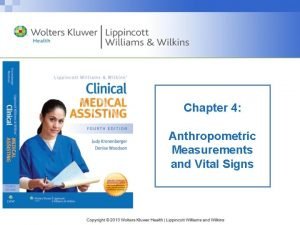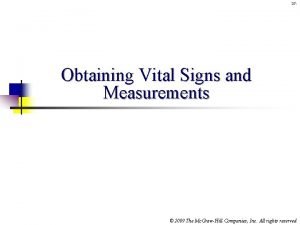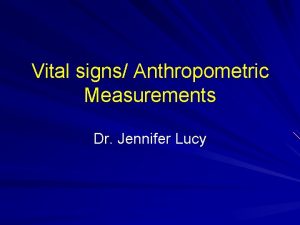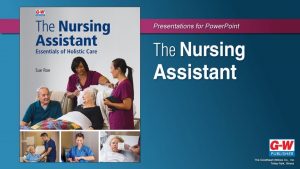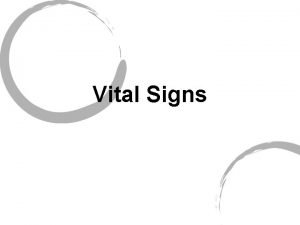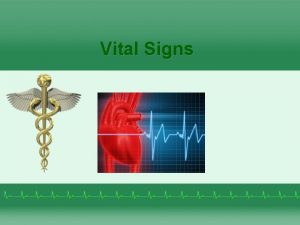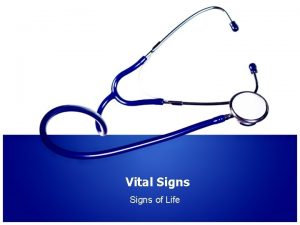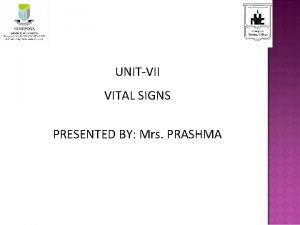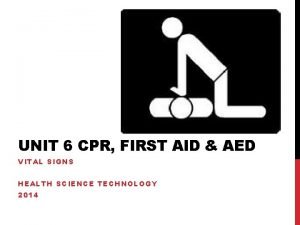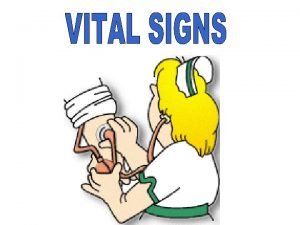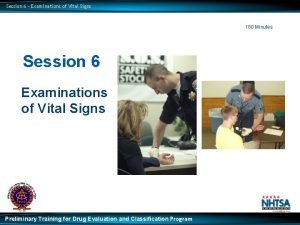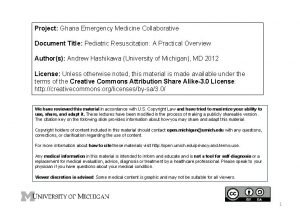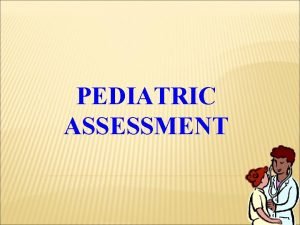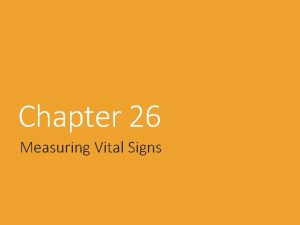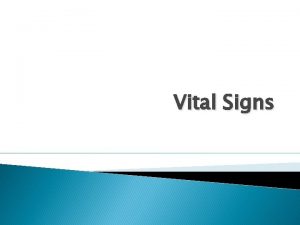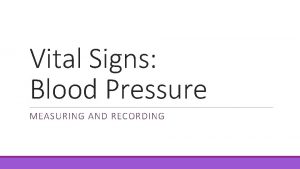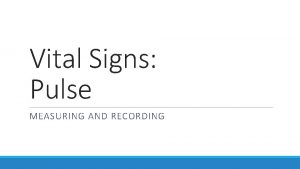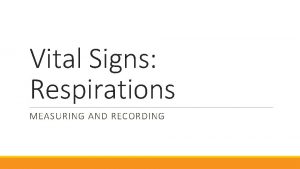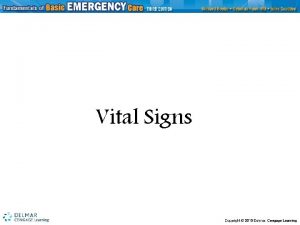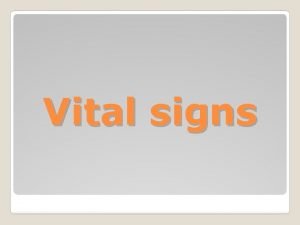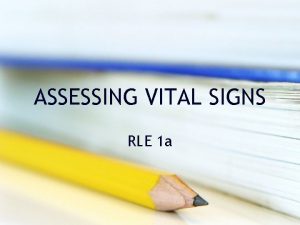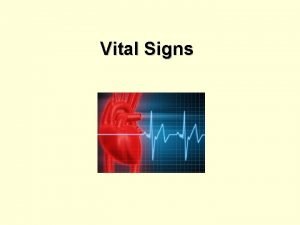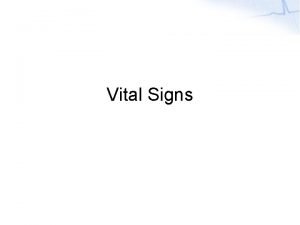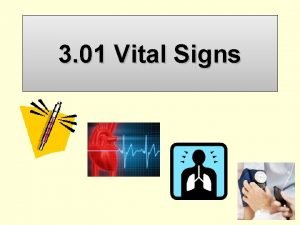Measuring and Recording Vital Signs Vital Signs n






































- Slides: 38

Measuring and Recording Vital Signs

Vital Signs n Four main: • Temperature • Pulse • Respiration • Blood pressure n Accuracy essential: • Abnormal vital signs often first indication of disease or abnormality • Never guess if having difficulty

Temperature n n Measurement of balance between heat lost and heat produced in body Heat loss: • Perspiration • Respiration • Excretion n Heat produced: • Metabolism of food • Muscle & gland activity

Temperature n Homeostasis: • Constant state of fluid balance • Ideal health state • Rate of chemical reactions regulated by body temp • Fluid balance affected by body temp

Temperature n Variations: • Individual differences Higher metabolism-higher temp n Slower metabolism-lower temp n • Time of day Lower in AM n Higher after muscular activity & food intake n

Temperature n Parts of body: • Oral temp Most common & convenient n Normal: 98. 6 F (37 C) n Thermometer left 3 -5 minutes n • Rectal temp Normal: 98. 6 -100. 6 F n Thermometer left 3 -5 minutes n Most accurate n

Temperature n Part of body, cont • Axillary or groin temp Normal: 97. 6 -98. 6 F n Thermometer left 10 minutes n An external temp & least accurate n • Aural temp Detects & measures thermal energy radiating from eardrum n A core temp-accurate n

Temperature n Factors Causing Increased Temp • Illness and infection • Exercise and/or excitement • High temps in environment n Factors Causing Decreased temp • Starvation or fasting • Decrease muscle activity • Cold temps in environment

Abnormal conditions: n Hypothermia: • Body temp below 95 F • Caused by prolonged exposure to cold n Hyperthermia: • Body temp exceeds 104 F • Caused by prolonged exposure to hot temps, brain damage or serious infection n Fever: • • • Elevated body temp Usually above 101 F Usually caused by infection or injury

Clinical Thermometers n Oral and Rectal: • Oral has long, slender bulb and/or blue tip • Rectal has short, stubby, rounded bulb & may be marked with red tip

Clinical Thermometers n Electronic: • Used to take all temps • Prevents contamination from patient to patient

Clinical Thermometers n Tympanic (aural): • Measures thermal, infrared energy radiating from eardrum • A core tempaccurate

Factors Affecting Temperature n n Eating Drinking hot or cold liquids Smoking Wait 15 minute before taking temp

Cleaning Glass Thermometer n n n Clean after each use Wipe with soapy cotton ball Rinse in cool water Shake mercury down Soak in disinfectant for minimum of 30 minutes Discard plastic sheaths

Measuring and Recording Pulse

Pulse n n The pressure of the blood pushing against the wall of an artery as the heart beats and rests More easily felt in arteries that lie close to skin and pressed against bone

Major Pulse Sites n n n n Temporal: side of forehead Carotid: side of neck Brachial: inner aspect of elbow Radial: inner aspect of wrist Femoral: inner aspect upper thigh Popliteal: behind knee Dorsalis pedis: top of foot arch

Factors to be Noted n Pulse rate • Noted as number beats per minute • Varies due to age, sex, body size n n n Adult: 60 -90 Men: 60 -70 Women: 70 -80 Children >7: 70 -90 Children 1 -7: 80 -120 Infants: 100 -160 • Bradycardia: pulse <60 • Tachycardia: pulse>100

Factors to be Noted n Pulse rhythm • Refers to regularity of pulse or spacing of beats • Described as regular or irregular n Pulse volume • Describes strength or intensity of pulse • Described by strong or weak; thready or bounding

Factors Affecting Pulse Rate n Increased rates: • • n Exercise/excitement Stimulant drugs Shock Nervous tension Decreased rates: • Sleep • Depressant drugs • Coma

Measuring and Recording Respirations

Measuring and Recording Respirations n n n Breathing rate of patient per minute One respiration: one inhale, one exhale Normal rates: • Adults: 14 -18 • Children: 16 -25 • Infants: 30 -50

Factors to be Noted n n Rate Character • Refers to depth & quality of respirations • Described as deep, shallow, labored, moist, difficult n Rhythm • Regularity or equal spacing between breaths • Described as regular or irregular

Abnormal Respirations n Dyspnea • Difficult or labored breathing n Apnea • Absence of respirations n Cheyne-Stokes • Periods of dyspnea followed by periods of apnea n Rales • Bubbling or noisy sounds caused by fluids or mucus in air passages

Control of Respirations n n n Partially under voluntary control If pt aware, may breath faster or slower Tips when counting: • Don’t tell • Keep hand on pulse site while measuring respirations so will think still counting pulse

Apical Pulse

Apical Pulse n n Taken at apex of heart Ordered for; • Irregular heart beats • Hardening of arteries • Weak or rapid radial pulses • Infants & children

Apical Pulse-Heart Sounds n n n 2 separate sounds-”lubb-dupp” Each “lubb-dupp” counts as one heart beat Report abnormal sounds or beats

Pulse Deficit n Taken when: • Heart too weak to produce pulse • Tachycardia-not enough time for refillno pulse produced n Accuracy essential: • On person measure apical pulse • 2 nd person measures radial pulse • Subtract radial from apical pulse=pulse deficit

Blood Pressure

Blood Pressure n n n Measurement of pressure exerted on arterial walls as heart contracts or relaxes Measured in mm. Hg Instrument: sphygmomanometer

Measurement of B/P n Systolic pressure • Pressure when heart contracting & pushing blood into arteries • Normal range: 100 to 140 mm. Hg n Diastolic pressure • Constant pressure in arteries when heart at rest • Normal range: 60 to 90 mm Hg

Factors Influencing B/P n n Force of heartbeat Resistance of arterial system Elasticity of arteries Volume of blood in arteries

Individual Factors Influencing B/P n Increase: • Excitement, anxiety, nervous tension • Stimulant drugs • Exercise and eating n Decrease: • Rest or sleep • Depressant drugs • Excessive blood loss

Individual Factors Influencing B/P n Miscellaneous readings • • • n Lying down Sitting Standing Don’t tell patient! • May cause personal reaction affecting treatment • Doctor’s responsibility to tell • Doctor determines if abnormal and treatment, if necessary

Recording B/P n Written as fraction: • Systolic over diastolic • 120/80 mm. Hg

Types of Sphygomomanometers n Mercury • Long column of mercury • Each line=2 mm. Hg n Aneroid • Round gauge • Each line=2 mm. Hg

B/P Cuffs n n Contains rubber bladder that applies pressure to arteries to stop blood flow Correct size important: • Width=diameter of pt’s arm • Too narrow: false high reading • Too large: false low reading
 Chapter 16.5 graphing tpr answer key
Chapter 16.5 graphing tpr answer key 16.6 measuring and recording apical pulse
16.6 measuring and recording apical pulse Chapter 16:1 measuring and recording vital signs
Chapter 16:1 measuring and recording vital signs Measuring and recording pulse
Measuring and recording pulse Regularity of the pulse or respirations
Regularity of the pulse or respirations Chapter 15:2 measuring and recording temperature
Chapter 15:2 measuring and recording temperature Recording vital signs
Recording vital signs Chapter 29 measuring vital signs
Chapter 29 measuring vital signs Measuring vital signs chapter 21
Measuring vital signs chapter 21 Sv times hr
Sv times hr Chapter 26 measuring vital signs
Chapter 26 measuring vital signs Chapter 27 vital signs
Chapter 27 vital signs Chapter 26 measuring vital signs
Chapter 26 measuring vital signs 16:3 measuring and recording pulse
16:3 measuring and recording pulse Chapter 21:1 measuring/recording height and weight
Chapter 21:1 measuring/recording height and weight 2009 delmar cengage learning
2009 delmar cengage learning Measuring and recording blood pressure
Measuring and recording blood pressure All traffic signs and meanings
All traffic signs and meanings Capacidad vital y capacidad vital forzada
Capacidad vital y capacidad vital forzada Vital signs and anthropometric measurements
Vital signs and anthropometric measurements Chapter 37 vital signs and measurements true or false
Chapter 37 vital signs and measurements true or false Vital sign normal
Vital sign normal For adult
For adult Vital signs height and weight
Vital signs height and weight Vital signs
Vital signs Vitals normal ranges
Vitals normal ranges Apical pulse
Apical pulse What are the 7 vital signs
What are the 7 vital signs Normal ranges for children's vitals
Normal ranges for children's vitals Sites of pulse rate
Sites of pulse rate What are the 8 vital signs?
What are the 8 vital signs? Normal vital ranges
Normal vital ranges Conclusion of vital signs
Conclusion of vital signs 6 vital signs first aid
6 vital signs first aid Sites of pulse
Sites of pulse 6 vital signs
6 vital signs Peds vitals
Peds vitals What are normal vital signs
What are normal vital signs Headss assessment
Headss assessment

